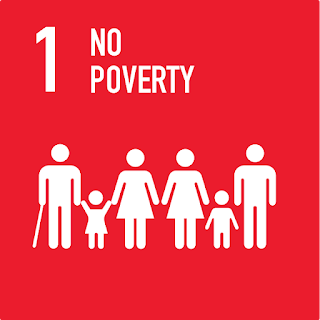Goal 1: No poverty
Sustainable Development Goal 1
SDG 1 is to: "End poverty in all its forms everywhere". Achieving SDG 1 would end extreme poverty globally by 2030.
Sustainable Development Goal 1 (SDG 1 or Global Goal 1), one of the 17 Sustainable Development Goals established by the United Nations in 2015, calls for the end of poverty in all forms. The official wording is: "No Poverty". Member countries have pledged to "Leave No One Behind": underlying the goal is a "powerful commitment to leave no one behind and to reach those farthest behind first". SDG 1 aims to eradicate every form of extreme poverty including the lack of food, clean drinking water, and sanitation. Achieving this goal includes finding solutions to new threats caused by climate change and conflict. SDG 1 focuses not just on people living in poverty, but also on the services people rely on and social policy that either promotes or prevents poverty.
The goal has seven targets and 13 indicators to measure progress. The five "outcome targets" are: eradication of extreme poverty; reduction of all poverty by half; implementation of social protection systems; ensuring equal rights to ownership, basic services, technology and economic resources; and the building of resilience to environmental, economic and social disasters. The two targets related to "means of achieving" SDG 1 are mobilization of resources to end poverty; and the establishment of poverty eradication policy frameworks at all levels.
Despite the ongoing progress, 10 percent of the world's population live in poverty and struggle to meet basic needs such as health, education, and access to water and sanitation. Extreme poverty remains prevalent in low-income countries particularly those affected by conflict and political upheaval. In 2015, more than half of the world's 736 million people living in extreme poverty lived in Sub-Saharan Africa. Without a significant shift in social policy, extreme poverty will dramatically increase by 2030. The rural poverty rate stands at 17.2 percent and 5.3 percent in urban areas (in 2016). Nearly half are children.
One of the key indicators that measure poverty is the proportion of population living below the international and national poverty line. Measuring the proportion of the population covered by social protection systems and living in households with access to basic services is also an indication of the level of poverty. Eradicating poverty has been made more difficult by the COVID-19 pandemic in 2020. Local and national lockdowns led to a collapse in economic activity that reduced or eliminated sources of income and accelerated poverty. A study published in September 2020 found that poverty increased by 7 percent in just a few months, even though it had been steadily decreasing for the last 20 years.








No comments:
Post a Comment